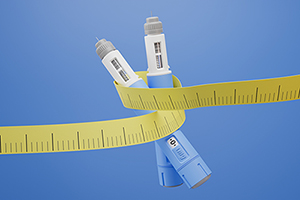



| By Dr. Ronald Hoffman
We approach all nutritional counseling at the Hoffman Center from the vantage point of blood sugar stabilization and optimized glucose tolerance. First let’s review the basic mechanism by which the body uses glucose and insulin. When you eat, the pancreas releases insulin to process the food. The insulin then carries the resultant glucose out of the blood and into the muscle cells so it can be used for energy.
Insulin resistance is a term that refers to the inability to properly use insulin. Typically, when we eat too many carbohydrates and/or too many refined carbs, the body becomes less and less sensitive over time to its own insulin. That’s because the pancreas responds to the high carb load by releasing even more insulin in an effort to overcome the resistance. So, insulin resistance is not a shortage of insulin, rather it is a dulling of the body’s response to a prolonged assault of too much insulin. We call this insulin resistance “Syndrome X.”
It is well known that people with Syndrome X are at increased risk for diabetes, cardiovascular disease and kidney disease. We know that part of the reason for this is that elevated levels of glucose and insulin over time can cause microscopic changes in the lining of blood vessels. Insulin resistance as detected by the Glucose Tolerance Test is as important a risk factor for heart disease and stroke as high cholesterol. Insulin resistance and blood sugar disturbances also may worsen other inflammatory disorders such as arthritis and asthma. Insulin resistance has even been implicated in certain cancers, especially breast and pancreatic cancer.
Patients with anxiety/depression, chronic fatigue, insomnia, palpitations, seizures, tremors, headaches and migraines often are very sensitive to blood sugar fluctuations. By doing a 5-hour GTT, we may identify spikes or sharp drops in blood sugar in hours 3 or 4 that facilitate our nutritional counseling, supplement regimen, and lead to significant mood stabilization and anxiety reduction.
Here are some more typical profiles of patients we screen with GTT’s. They are at increased risk for diabetes and heart disease:
How the GTT works
After a special diet prep that is reviewed in detail with our nutritionist, patients return to the office. A special device called a heparin lock is inserted into the vein in the arm. This allows blood samples to be taken painlessly without repeated needle sticks. These will be taken every hour until the conclusion of the test. At that point, patients are encouraged to eat a protein snack they’ve been asked to bring with them. Any potential transient side effects, such as nausea or light-headedness, usually go away when the patient eats food.
Though we think of declining estrogen as the hallmark of menopause, it's actually common for…

Up to 12 percent of Americans have ulcers at some point in life. Peptic ulcers…
Gallbladder disease is a modern illness. An estimated 20 million Americans have gallbladder disease. The…

New, more powerful weight loss drugs: Drugs like Wegovy, Rybelsus, Ozempic and Mounjaro/Zepbound are revolutionizing…

According to the Lancet, autoimmune disease affects one in ten people globally and it’s now…

This past week we were regaled with headlines like: High levels of niacin may increase…

Leyla Weighs In: The Erosion of Trust in Nutritional Research

Our virtual voicemail is open 24/7, so there's no need to wait to submit your questions for Dr. Hoffman. Leave a message, and you may hear your question featured on the Intelligent Medicine radio program!